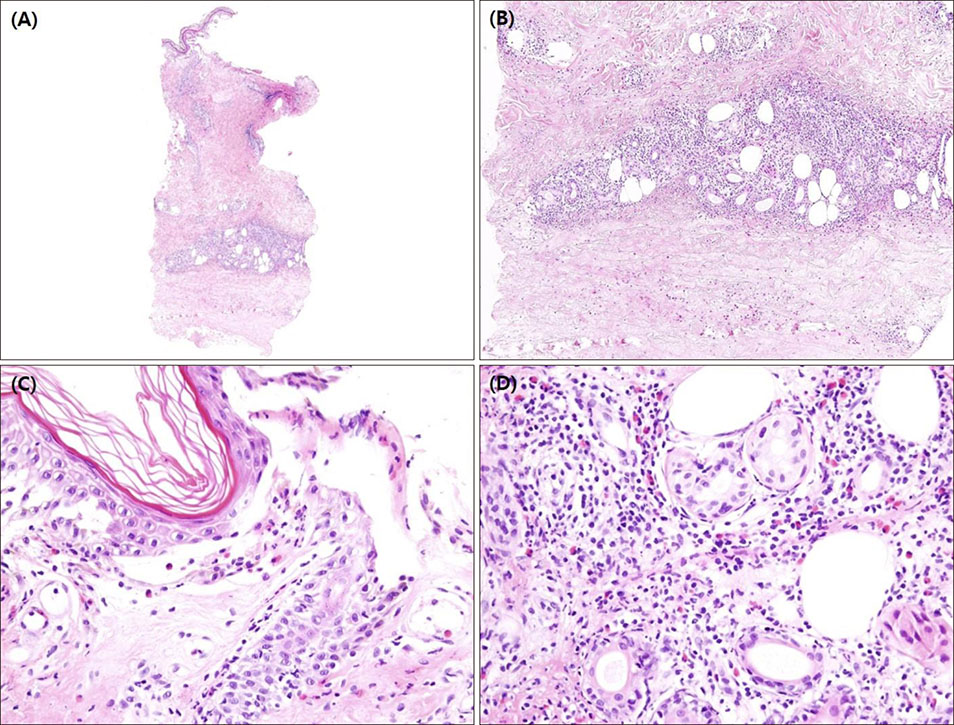Ann Dermatol.
2018 Aug;30(4):468-472. 10.5021/ad.2018.30.4.468.
Insect Bite-Like Reaction with Bullous Lesions Mimicking Bullous Pemphigoid in a Patient with Chronic Lymphocytic Leukemia
- Affiliations
-
- 1Department of Dermatology, Gangnam Severance Hospital, Cutaneous Biology Research Institute, Yonsei University College of Medicine, Seoul, Korea. kimsc@yuhs.ac
- KMID: 2457527
- DOI: http://doi.org/10.5021/ad.2018.30.4.468
Abstract
- Patients with chronic lymphocytic leukemia (CLL) rarely exhibit an exaggerated insect bite-like reaction without a history of an arthropod bite. We report a case of an insect bite-like reaction in a 74-year old man with CLL. The patient presented with a 2-year history of recurrent itchy erythematous patches and blisters on the whole body. He had been diagnosed with CLL 2 years ago, and the skin lesions developed 1 month after remission. The result of a skin biopsy was consistent with insect bite. Immunohistochemical staining of the infiltrated cells showed positive reactions for CD3, CD5 and negative for CD20, CD23. Direct and indirect immunofluorescence revealed negative results. The patient was treated with oral prednisolone and dapsone, under the diagnosis of CLL-associated insect bite-like reaction, and showed marked improvement. Dermatologist should be aware of insect bite-like reaction associated with CLL as a distinct disease entity that is similar to insect bite or bullous pemphigoid.
MeSH Terms
Figure
Reference
-
1. Wierda WG, Zelenetz AD, Gordon LI, Abramson JS, Advani RH, Andreadis CB, et al. NCCN guidelines insights: chronic lymphocytic leukemia/small lymphocytic leukemia, version 1.2017. J Natl Compr Canc Netw. 2017; 15:293–311.
Article2. Bairey O, Goldschmidt N, Ruchlemer R, Tadmor T, Rahimi-Levene N, Yuklea M, et al. Insect-bite-like reaction in patients with chronic lymphocytic leukemia: a study from the Israeli chronic lymphocytic leukemia study group. Eur J Haematol. 2012; 89:491–496.
Article3. Weed RI. Exaggerated delayed hypersensitivity to mosquito bites in chronic lymphocytic leukemia. Blood. 1965; 26:257–268.
Article4. Barzilai A, Shpiro D, Goldberg I, Yacob-Hirsch Y, Diaz-Cascajo C, Meytes D, et al. Insect bite-like reaction in patients with hematologic malignant neoplasms. Arch Dermatol. 1999; 135:1503–1507.
Article5. Byrd JA, Scherschun L, Chaffins ML, Fivenson DP. Eosinophilic dermatosis of myeloproliferative disease: characterization of a unique eruption in patients with hematologic disorders. Arch Dermatol. 2001; 137:1378–1380.6. Mitteldorf C, Tronnier M, Merz H, Haenssle HA, Bertsch HP, Schön MP, et al. Insect bite-like reactions in a patient with B-cell chronic lymphocytic leukaemia: fluorescence in situ hybridization analysis revealed neoplastic B cells within the skin infiltrate. Br J Dermatol. 2012; 167:944–946.
Article7. Butzmann CM, Kern JS, Stanislawski G, Meiss F. Insect bite-like reaction in a patient with chronic lymphocytic leukemia. J Dtsch Dermatol Ges. 2014; 12:734–737.
Article8. Robak E, Robak T. Skin lesions in chronic lymphocytic leukemia. Leuk Lymphoma. 2007; 48:855–865.
Article9. Ulmer A, Metzler G, Schanz S, Fierlbeck G. Dapsone in the management of “insect bite-like reaction” in a patient with chronic lymphocytic leukaemia. Br J Dermatol. 2007; 156:172–174.
Article10. Davis MD, Perniciaro C, Dahl PR, Randle HW, McEvoy MT, Leiferman KM. Exaggerated arthropod-bite lesions in patients with chronic lymphocytic leukemia: a clinical, histopathologic, and immunopathologic study of eight patients. J Am Acad Dermatol. 1998; 39:27–35.
Article
- Full Text Links
- Actions
-
Cited
- CITED
-
- Close
- Share
- Similar articles
-
- A Case of Bullous Pemphigoid Following Chronic Lymphocytic Leukemia
- Coexistence of Bullous Pemphigoid and Psoriasis: A Case Report and Review of the Literature
- Atypical Variant of Bullous Pemphigoid: Prolonged Eruptions of Papulourticarial Lesions
- A Case of Bullous Pemphigoid Associated with Prostate Adenocarcinoma
- Bullous Pemphigoid Responding to DDS




